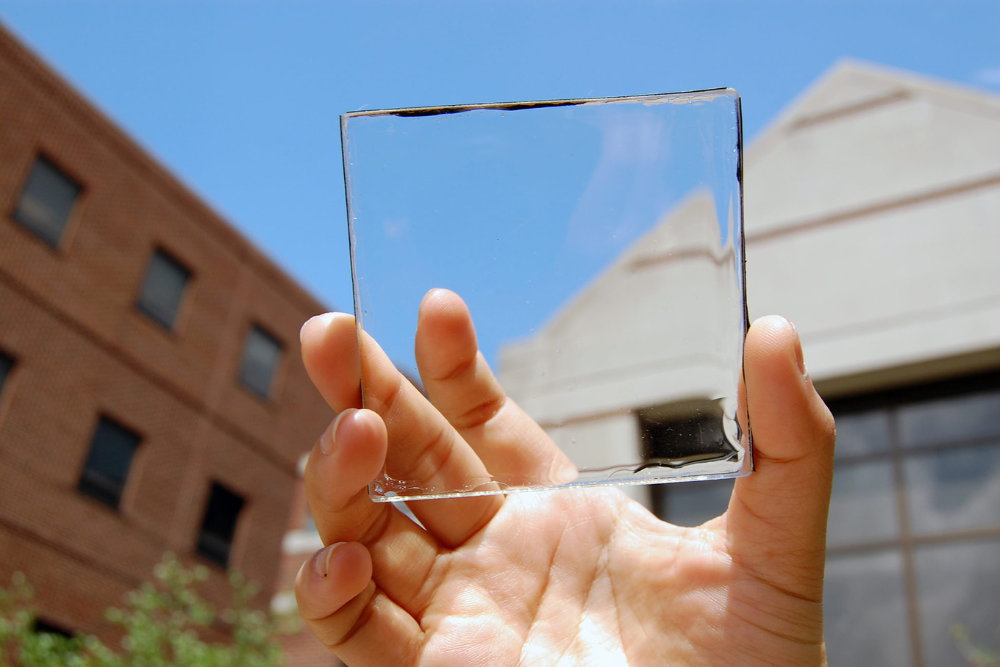Korean Scientists Create Transparent Solar Panels That Allow Windows To Generate Electricity
Cities are growing, and space is rapidly becoming a prized commodity. Rooftops are crowded with solar panels, and finding open land for installing renewable energy systems is increasingly difficult. Traditional solar panels, while effective in generating clean energy, require dedicated space that we can’t always spare. But what if the glass structures surrounding us—windows, skyscrapers, and even car windshields—could silently generate clean energy while remaining fully transparent and functional?

This isn’t science fiction—transparent solar panels are making it a tangible reality. This innovative technology brings renewable energy into cityscapes and urban infrastructure without disrupting architectural aesthetics or functionality. From office windows generating electricity to smartphone screens doubling as power sources, transparent solar cells blend form and function to create a future that’s both energy-efficient and visually seamless.
Redefining Renewable Energy with Transparent Solar Panels
Transparent solar panels are a groundbreaking advancement that solve a critical challenge of conventional solar systems—space efficiency. By turning everyday glass into a power source, they integrate sustainability into the urban fabric without sacrificing design or transparency. Unlike traditional systems that need allocated spaces for installation, transparent solar panels transform windows, facades, and portable devices into invisible generators of clean energy.
The concept behind this technology lies in selectively absorbing invisible wavelengths of light—such as ultraviolet (UV) and near-infrared—while allowing visible light to pass through, maintaining transparency. The captured light is then redirected to photovoltaic cells along the panel’s edges, where it’s converted into electricity.
“The potential to turn every glass surface—from skyscraper windows to smartphone screens—into a power-producing material is not just innovation, but a reimagination of solar energy as we know it,” says Richard Lunt, lead researcher behind the first fully transparent solar concentrator at Michigan State University.
Breakthroughs in Transparent Solar Technology

Transparent solar technology has been steadily evolving since its inception in 2014 when MSU researchers created the first transparent solar concentrator. Early prototypes achieved just 1% efficiency, but continuous research has boosted this number to around 5%, with some designs aiming for over 10% in the near future. Companies like Ubiquitous Energy have developed panels achieving a record energy conversion efficiency of 9.8%, proving that the technology is taking significant leaps.
Recent developments by scientists at Korea’s Incheon National University have further amplified the promise of transparent solar cells. By using titanium dioxide (TiO₂) and nickel oxide (NiO)—two non-toxic and abundant materials—they created a fully transparent solar cell capable of capturing UV light effectively. According to a report in the Journal of Power Sources, this innovation is a major step toward clean energy integration that doesn’t compromise aesthetics.
Professor Joondong Kim, who led the team at Incheon University, explained, “The unique features of transparent photovoltaic cells could have various applications in human technology.” From energy-efficient buildings to devices that charge themselves, the possibilities are vast.
Why Transparent Solar Panels Matter Today
The race for renewable energy solutions couldn’t be timelier. Five years after the Paris Climate Agreement, countries worldwide are setting aggressive goals to transition away from fossil fuels. Solar energy remains at the forefront of this race, accounting for over 60% of all renewable capacity additions globally in 2022, according to the International Renewable Energy Agency (IRENA).
Traditional solar systems, however, face limitations in cities where space is a premium. Transparent solar panels address this issue by integrating seamlessly into urban environments—offering energy solutions that don’t require additional land or bulky installations.
Additionally, as climate change accelerates, there’s an increasing need for innovations that align with carbon neutrality goals. Transparent solar panels fit perfectly into this narrative, providing buildings and cities an effortless way to reduce their environmental impact and operational energy costs.
Applications Across Industries
The potential applications of transparent solar panels span across a wide range of industries:
- Architecture: Commercial skyscrapers, residential homes, and office spaces can integrate transparent solar panels into windows and facades, creating energy-efficient buildings without compromising design.
- Public Infrastructure: Train stations, bus stops, and other urban spaces can be powered using solar-integrated glass installations, leading to smarter, more sustainable cities.
- Consumer Technology: Smartphones, smartwatches, and other electronic devices can use transparent solar cells to extend battery life, reducing dependency on recharging.
- Automobiles: Car windshields and windows could generate energy to power electric vehicles or auxiliary systems while maintaining clear visibility.
Challenges Ahead
Despite their immense potential, transparent solar panels are not without challenges. The most significant roadblock is economic viability. Current prototypes require advanced materials like perovskites and precise manufacturing processes, leading to higher costs. However, as production scales and research progresses, costs are expected to drop significantly.
Another hurdle is efficiency. Transparent panels must balance energy conversion with visual clarity. While new materials like titanium dioxide and perovskites are closing the gap, traditional opaque panels still outperform in terms of energy output. Advancements in material sciences and engineering will be essential to overcoming these performance limitations.
Shaping the Future of Renewable Energy
While challenges remain, transparent solar panels represent a genuine leap forward in renewable energy integration, with the power to shape the future of urban sustainability. Their ability to transform every glass surface into an energy generator makes them uniquely suited to address the environmental and spatial challenges of our modern world.
Imagine living in a city powered not just by rooftop solar arrays but by office windows, streetlights, and even the glass facade of your local café. Transparent solar panels have the potential to make this vision a reality, marking a pivotal step forward in achieving carbon neutrality and reshaping the energy landscape.
The Clear Path Ahead
Transparent solar panels demonstrate that innovation doesn’t have to disrupt—it can blend seamlessly into our lives. By redefining how renewable energy integrates into urban environments, this technology aligns beautifully with the modern quest for sustainability. Though hurdles like cost and efficiency remain, these are challenges that research and development are well on their way to solving.
The promise of clear, invisible energy generation has moved from concept to reality and from niche to necessity. Transparent solar panels don’t just solve energy challenges—they reflect a broader philosophy of creating a world where functionality, beauty, and sustainability coexist in perfect harmony. The question isn’t if we’ll adopt this technology—it’s how soon we’ll see its full potential unfold.



